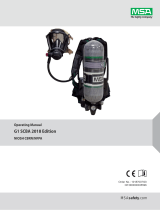
Page 8 of 48P/N 595279-01 Rev. B 5/14
WARNING
FIT TESTING IN ACCORDANCE WITH OSHA
STANDARD 29 CFR PART 1910 IS REQUIRED
AS PART OF THE REQUIRED TRAINING
BEFORE USE OF THIS RESPIRATOR.
FAILURE TO PROPERLY FIT AND TRAIN
THE USER IN USE OF THE FACEPIECE AND
RESPIRATOR MAY RESULT IN EXPOSURE
TO THE HAZARDOUS ATMOSPHERE WHICH
COULD LEAD TO SERIOUS INJURY OR
DEATH.
FACEPIECE FITTING AND FIT TESTING
A respirator Quantitative Fit Test must be performed to ensure the correct
respirator facepiece size has been selected and assigned to the user. It is
the responsibility of the Respiratory Protection Program Manager or Safety
Coordinator to assist the user in selecting the correct respirator size relative
to the user’s facial features and dimensions. Fit Testing must be performed
with any approved SCOTT accessories that will be used with the respirator
installed, such as a communications device installed on the facepiece.
Refer to NIOSH Procedure No. RB-CET-STP-CBRN-0352, DETERMINA-
TION OF LABORATORY RESPIRATOR PROTECTION LEVEL (LRPL)
QUANTITATIVE, MEDIUM FLOW, DEEP PROBE, CORN OIL, FIT FACTOR
PERFORMANCE TEST FOR CHEMICAL, BIOLOGICAL, RADIOLOGICAL
and NUCLEAR (CBRN) FULL FACEPIECE RESPIRATORY PROTECTION
DEVICES (RPD) STANDARD TESTING PROCEDURE Attachment C, Sizing
and Test Panels for LRPL for details.
The size and style facepiece must be selected based on the user’s measured
face size. For initial fitting, carefully don the facepiece and conduct a NEGATIVE
PRESSURE LEAK TEST. Refer to the DONNING PROCEDURE section of this
instruction for the procedure. Follow the DONNING PROCEDURE CAREFULLY.
If the selected facepiece does not pass the NEGATIVE PRESSURE LEAK TEST
or does not fit securely without movement in the chin or chin cup area or the
user experiences discomfort in the chin or throat, try the next nearest size,
larger or smaller. After passing the NEGATIVE PRESSURE LEAK TEST, the
facepiece size selected must be verified by successfully passing a respirator
Quantitative Fit Test.
Respirator fit tests are explained fully in the American National Standard
Practices for Respiratory Protection, ANSI Z88.10-2001 which is published
by the American National Standards Institute (ANSI), 11 West 42nd Street,
New York, New York, 10036, and in the Occupational Safety and Health
Standards, OSHA 29 CFR 1910.134 Appendix A, which is published by the
Occupational Safety and Health Administration (OSHA), 200 Constitution
Avenue, NW, Washington DC, 20210.
Quantitative Fit Testing per OSHA Standard 29 CFR Part 1910.134 Appendix
A, or ANSI Standard Z88.10-2001 requires testing in the negative pressure
mode using equipment such as a Portacount
1
Respirator Fit Tester. For Quan-
titative Fit Testing, SCOTT facepieces require use of the appropriate negative
pressure testing equipment such as the Portacount Respirator Fit Tester along
with the following:
• SCOTT 40mm facepiece adapter, P/N 200423-01,
• a new SCOTT CBRN CAP-1 Canister, P/N 045135 or SCOTT P100 Car-
tridge, P/N 052683**,
• SCOTT Probed Fit Test Adapter P/N 805628-01 or equivalent probed
facepieces and the full range of sizes and styles
• Mask Seal Kit, P/N 805655-01
• the appropriate SCOTT communications device and mounting bracket
properly installed on the facepiece
• the optional SCOTT AV-NBC Shroud, P/N 31000558.
Depending on whether the user is fit testing for CBRN SCBA Open Circuit
mode of operation (minimum Fit Factor equal to or greater than 500 minimum)
or CBRN APR (minimum Fit Factor equal to or greater than 2000 minimum)
appropriate negative pressure testing equipment must be used. For example,
if you are Fit Testing for CBRN SCBA Open Circuit or CBRN APR, you should
use a P100 Filter, SCOTT P/N 052683 and the SCOTT P/N 805628-01 Fit
Test Adapter. If you are using a Facepiece that has been specially modified
for a Fit Testing Program such as that described in NIOSH Procedure No.
RB-CET-STP-CBRN-0352, DETERMINATION OF LABORATORY RESPIRA-
TOR PROTECTION LEVEL (LRPL) QUANTITATIVE, MEDIUM FLOW, DEEP
PROBE, CORN OIL, FIT FACTOR PERFORMANCE TEST FOR CHEMICAL,
BIOLOGICAL, RADIOLOGICAL and NUCLEAR (CBRN) FULL FACEPIECE
RESPIRATORY PROTECTION DEVICES (RPD) STANDARD TESTING PRO-
CEDURE, you should install the appropriate filtration element directly into
the 40 mm facepiece adapter.
WARNING
THE USER MUST BE PROPERLY FITTED
USING A RESPIRATOR QUANTITATIVE FIT
TEST BEFORE USE AND FOLLOW ALL
WARNINGS AND SPECIAL OR CRITICAL
USER’S INSTRUCTIONS SPECIFIED DURING
USE. FAILURE TO DO SO MAY RESULT IN
SERIOUS INJURY OR DEATH.
WARNING
RESPIRATORS SHALL NOT BE WORN WHEN
CONDITIONS PREVENT A GOOD FACE SEAL.
SUCH CONDITIONS MAY INCLUDE, BUT
ARE NOT LIMITED TO, FACIAL HAIR SUCH
AS GROWTH OF BEARD OR SIDEBURNS,
OR LOW HAIRLINE THAT CROSSES OR
INTERFERES WITH THE SEALING SURFACE,
THICK OR PROTRUDING HAIRSTYLES SUCH
AS PONY TAILS OR BUNS THAT INTERFERE
WITH THE SMOOTH AND CLOSE FIT OF
THE HEAD HARNESS TO THE HEAD, A
SKULL CAP THAT PROJECTS UNDER
THE FACEPIECE, OR TEMPLE PIECES ON
GLASSES. ALSO, THE ABSENCE OF ONE
OR BOTH DENTURES CAN SERIOUSLY
AFFECT THE FIT OF A FACEPIECE. USE OF
AN IMPROPERLY FITTED FACEPIECE MAY
LEAD TO EXPOSURE TO THE HAZARDOUS
ATMOSPHERE WHICH COULD RESULT IN
SERIOUS INJURY OR DEATH.
**Depending on whether the user is fit testing for CBRN SCBA Open Circuit mode of
operation (minimum Fit Factor equal to or greater than 500) or CBRN APR (minimum
Fit Factor equal to or greater than 2000).























